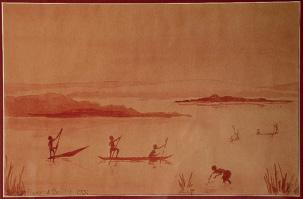The ICCM Journal | Autumn 2020 | V88 No. 3
61
pulpit: tragedy averted in Belgian Congo A glimpse at a brave attempt to serve the people of Bolobo as a medical Missionary, which almost ended in tragedy. In the summer edition of the Journal, 2020, I reported on the strange stories emanating from the graves of two sailors in the village cemetery of Burton Bradstock in Dorset. Another reason for my wife Marion and I to visit Burton Bradstock cemetery is that Marion’s parents are also buried here, and they too have a moving story to tell. They died in 1986 and 1990 respectively, but the simple information on the headstone, just a few yards away from the two Seamen, doesn’t do justice to the qualities and values that were motivating them in their life, at the start of the 20th century, nor does it acknowledge the daily risks which they faced. Ralph Stanford trained to become a Doctor at the London Hospital in Whitechapel, and as a young man, he had a vision of using his skills and knowledge to bring health and support to some of the people of this world who needed it most. He became a Medical Missionary with the Baptist Missionary Society and went to The Belgian Congo, as it was then called, to be a medical doctor at Bolobo, a village with a medical centre some 500 miles up the Congo River. The Society funded his training as a medical student which proved to be a critical support. Going to the Congo, learning French, and leaving family behind, was a brave and selfsacrificial decision, and Ralph concluded his first three years very successfully, returning home for a break, or furlough as it was called, but was busy preparing to go back to Bolobo for a second term of three years. This time, he took with him Frieda, his very new wife and a whole new phase of life started for them, including the birth of Peter, their first child, in Bolobo. Frieda was an alumnus of the Froebel Institute, a college which produced some fine educationalists and artists. On the right is a stunning painting of the scene at Bolobo as the ship arrived to deliver it’s cargo and passengers. Marion’s mother Frieda told us how she came to paint this picture of the Congo River at Bolobo. The journey to Africa was by boat, in those days, and as they travelled up river and approached Bolobo, Frieda had a sudden and irresistible urge to paint the scene. Her painting equipment was in the ship’s hold, and so inaccessible, in the immediate term, but she looked around and found some brown paper and a red ink pen and just drew the scene, on the spur of the moment. The effect is stunning, and I am pleased to say that this art decorates the wall of our house to this day. The Congo River at Bolobo, 1931
Frieda Stanford at her easel surrounded by her artwork, c. 1960.
Frieda’s portrait of her husband Ralph















